So, how has physics been this past year? Let’s start by taking a look at Physics World. In an article dated 7th December 2023, online editor Hamish Johnston said this: “Physics World is delighted to announce its top 10 Breakthroughs of the Year for 2023, which ranges from research in astronomy and medical physics to quantum science, atomic physics and more”. He went on to say the winner will be revealed on 14th December. Sounds good. So, Hamish, what have you got?
1. Growing electrodes inside living tissue
Johnston described the top 10 breakthroughs in chronological order, starting with Growing electrodes inside living tissue. Follow the hyperlink to read the original Physics World article dating from March 2023. There is of course a link to the relevant paper, namely Metabolite-induced in vivo fabrication of substrate-free organic bioelectronics. It was published in Science, and unfortunately is paywalled. However the determined detective can usually find a non-paywalled copy somewhere. Mum’s the word. Here’s figure 1:
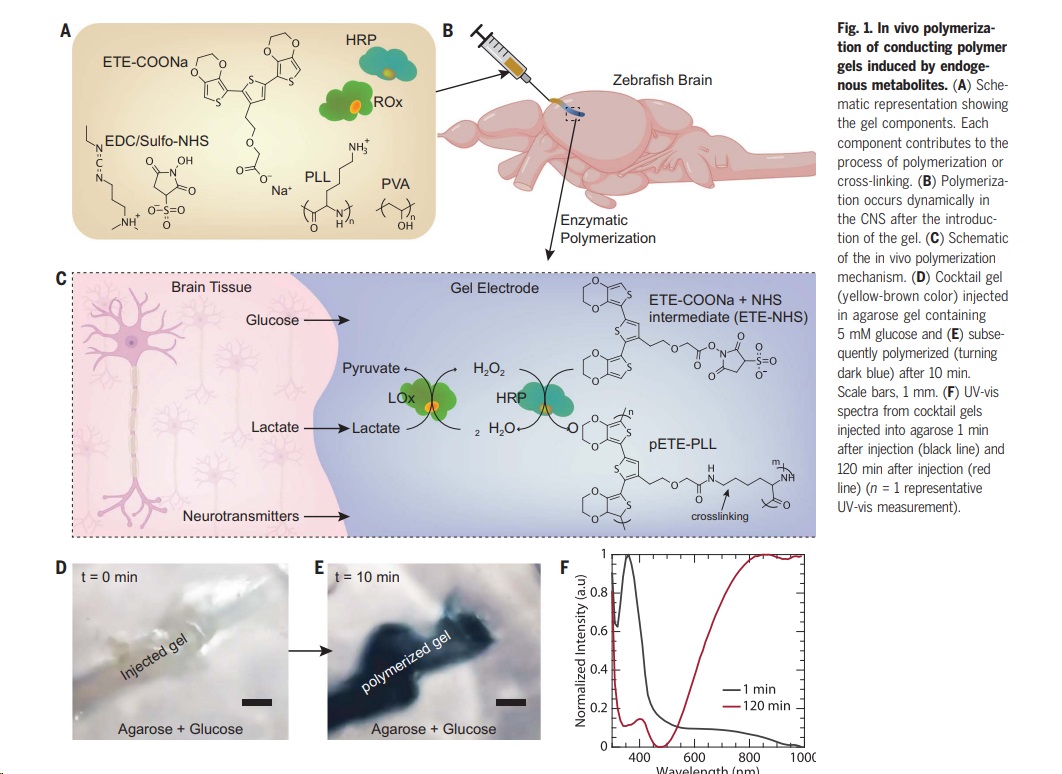 Image from Metabolite-induced in vivo fabrication of substrate-free organic bioelectronics by Strakosas et al.
Image from Metabolite-induced in vivo fabrication of substrate-free organic bioelectronics by Strakosas et al.
What do I think? I think it looks like good research by Xenofon Strakosas and 16 other authors, and I think it may have some interesting applications. Hey, it’s messing around with brains, what’s not to like? It reminds me of the old cyberpunk science fiction where people living in some dystopian dark future had all sorts of implants and Borg-like augmentations. But whilst I think it looks like good research, I have to say it just isn’t physics. It’s biochemistry.
2. Neutrinos probe the proton’s structure
I can’t say the same for Johnston’s second item, which is Neutrinos probe the proton’s structure. That’s definitely physics, and of definite interest to me. Why, I’ve even written two successive articles called the proton and the neutrino. However when I followed the link to the original Physics World article article, I was disappointed. It started off well enough. A postdoc called Tejin Cai, working on the Fermilab MINERvA experiment, came up with the idea to use antineutrino scattering to learn something about proton structure. The relevant paper in Nature is Measurement of the axial vector form factor from antineutrino–proton scattering. I’m pleased to say it’s open access. I’m not so pleased with the findings. There’s no proton structure here, and no mention of the crucial proton g factor, which is 5.585. Instead we have graphs galore and error bars and “direct comparisons with the increasingly precise lattice quantum chromodynamics computations”.
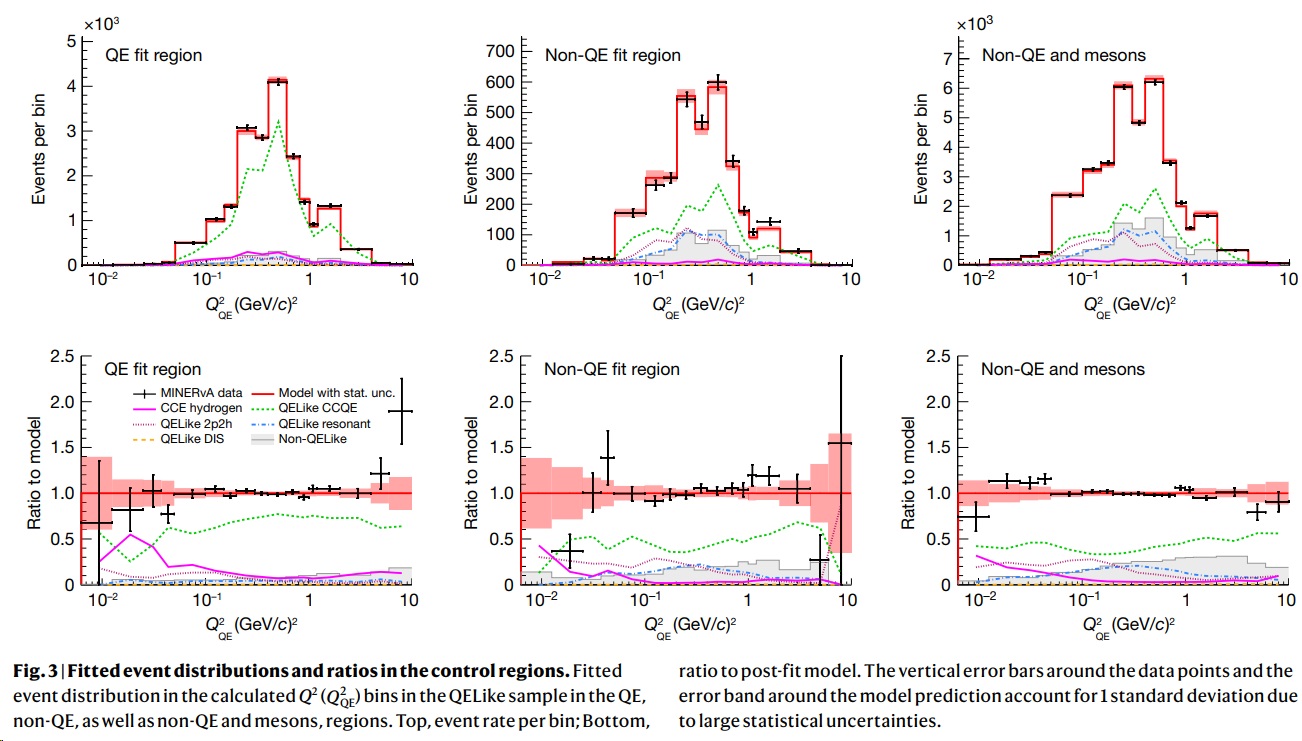 Image from Measurement of the axial vector form factor from antineutrino–proton scattering by Cai et al.
Image from Measurement of the axial vector form factor from antineutrino–proton scattering by Cai et al.
I’ve seen this sort of thing before from Big Science collider collaborations. I also know about the history of QED. So, if you were to ask me if future work in this area will come up with any advance in mainstream understanding of the proton, I’d say it won’t. There will be no near-threefold spinor wave structure coming out of this. All we’ll get is reams of handwaving and graphs followed by some quark-model rabbit out of a hat which “proves that the Standard Model is correct”. Hence I don’t see this as a breakthrough. Particle physics has dug itself into too deep a hole for that.
3. Simulating an expanding universe in a BEC
Johnston’s next pick was Simulating an expanding universe in a BEC. There were some immediate red flags in the original article. The first was the reference to cosmic inflation, which remains speculative, and was not simulated. The second was the phrase “spatial curvature”, which is not the same thing as curved spacetime. This was closely followed by “quantum particles follow trajectories determined by the curvature of the spacetime in which they move”. This is not true, because there is no motion in spacetime, and because “the curvature of light rays occurs only in spaces where the speed of light is spatially variable”. Photons curve where there’s a spacetime gradient, they don’t follow the curvature of spacetime. For the cherry on top, the expansion of space was simulated by decreasing the speed of sound in the BEC. Has nobody read the Einstein digital papers? You might want to blame these red flags on the author of the Physics World article, but everything he said came from the (freely-available) Nature paper Quantum field simulator for dynamics in curved spacetime. Which means the whole thing is valueless, because it’s based upon zero understanding of gravity, the expanding universe, dark matter, or curved spacetime. This is definitely no breakthrough.
4. A double slit in time
Johnston’s next item was A double slit in time, which referred to the double-slit experiment. It said “a material in which two slits rapidly appear and then disappear, one after the other, should cause incoming waves to maintain their path in space but spread out in frequency”. The original Physics World article says physicists have conducted the double slit experiment with single photons and still seen interference fringes, “implying that light is both a wave and a particle”. It doesn’t imply that. It demonstrates that a photon is a wave, as you would expect from expressions like E=hc/λ. Has nobody read Pascual Jordan’s resolution of the conundrum of the wave-particle duality of light by Anthony Duncan and Michel Janssen? Clearly not, but I digress. The article concerns a Nature Physics paper called Double-slit time diffraction at optical frequencies by Romain Tirole and eight other authors. Again it’s freely available. Perhaps Johnston had a hand in that, which is good. It’s also on the arXiv which is also good.
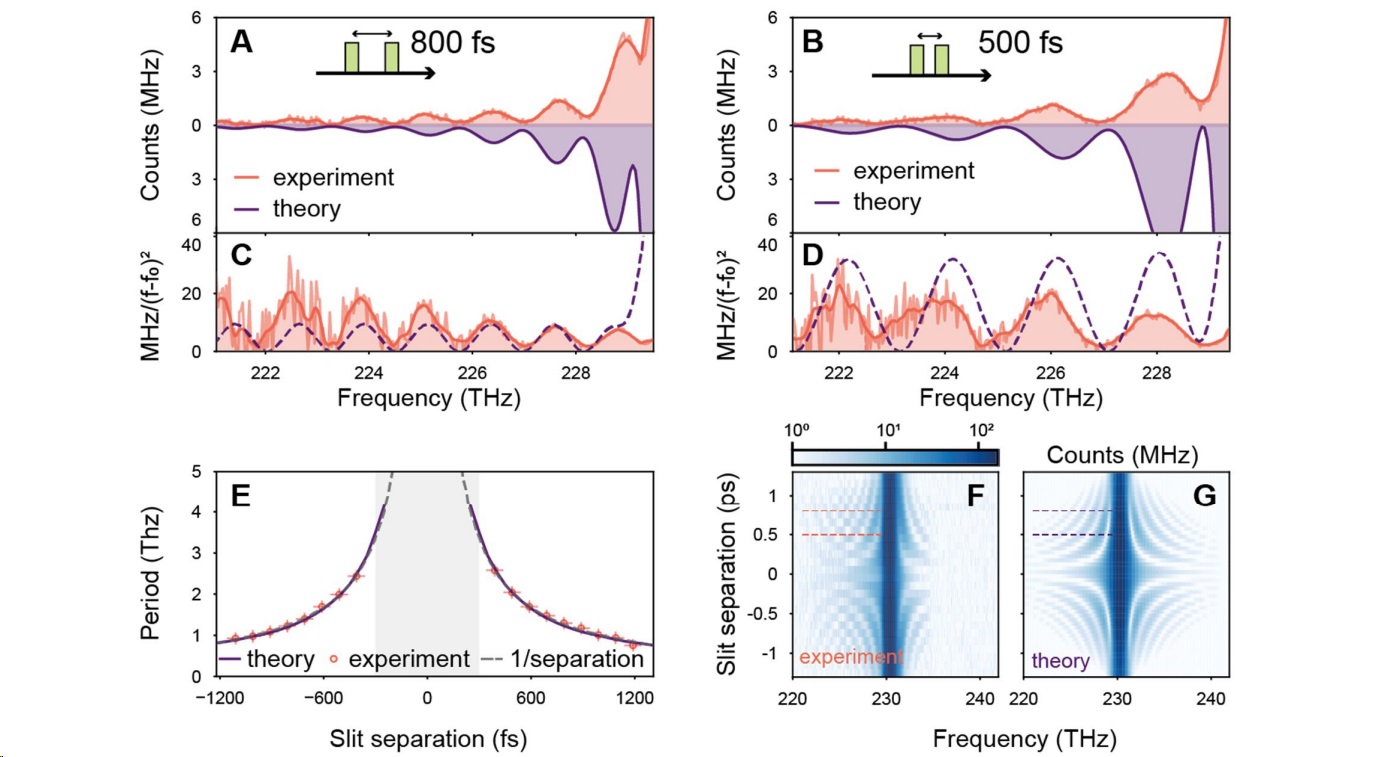 Image from Double-slit time diffraction at optical frequencies by Tirole et al.
Image from Double-slit time diffraction at optical frequencies by Tirole et al.
What’s not so good is that there’s a mundane explanation for the double-slit experiment – the act of detection at the screen or a slit performs something akin to an optical Fourier transform, so you “focus” a wave into something pointlike. I think there’s something similarly mundane here, where fast changes from absorption to reflection chop up the incoming wave resulting in interference. Perhaps there will be some useful applications, but I was not particularly impressed.
5. Digital bridge enables natural walking after spinal cord injury
I was however impressed by Digital bridge enables natural walking after spinal cord injury. Check out the June 2023 Physics World article Brain–spine interface enables natural walking after spinal cord injury as well as the Nature paper Walking naturally after spinal cord injury using a brain–spine interface. Yet again it’s freely available. It’s by 35 authors, including Grégoire Courtine, Guillaume Charvet, and Jocelyne Bloch. It says this: “A spinal cord injury interrupts the communication between the brain and the region of the spinal cord that produces walking, leading to paralysis. Here, we restored this communication with a digital bridge between the brain and spinal cord that enabled an individual with chronic tetraplegia to stand and walk naturally in community settings”.
 Restoring control: a digital bridge between the brain and spinal cord helped an individual with paralysis to walk naturally. (Courtesy: CHUV / Gilles Weber)
Restoring control: a digital bridge between the brain and spinal cord helped an individual with paralysis to walk naturally. (Courtesy: CHUV / Gilles Weber)
How heartening. A man in a wheelchair might walk again. If only this had been around for Christopher Reeve. This is life-changing, and ordinarily I would say this should be the outright winner. But this is medicine plus computing, or more properly “neural engineering”. It isn’t physics. So I can’t count it as a physics breakthrough.
6. Building blocks for a large-scale quantum network
I felt the same about Johnston’s next selection, but for a very different reason. It was Building blocks for a large-scale quantum network. The original article was Quantum repeater transmits entanglement over 50 kilometres. It refers to the Physical Review Letters paper Telecom-Wavelength Quantum Repeater Node Based on a Trapped-Ion Processor by Ben Lanyon and seven other authors. It’s paywalled, but you can find a version on the arXiv. The original article says physicists “have combined all the key functionalities of a long-distance quantum network into a single system”. They used this “to transfer quantum information via a so-called repeater node over a distance of 50 kilometres – far enough to indicate that the building blocks of practical, large-scale quantum networks may soon be within reach”. Such networks “could work by connecting the quantum bits (or qubits) of multiple quantum computers to ‘share the load’ of complex quantum calculations”. The blurb says “New quantum repeaters could enable a scalable quantum internet”. So why don’t I consider this to be a breakthrough? Because I’ve looked carefully at the history of quantum entanglement, and I am confident that it’s based on a misunderstanding of Malus’s Law:
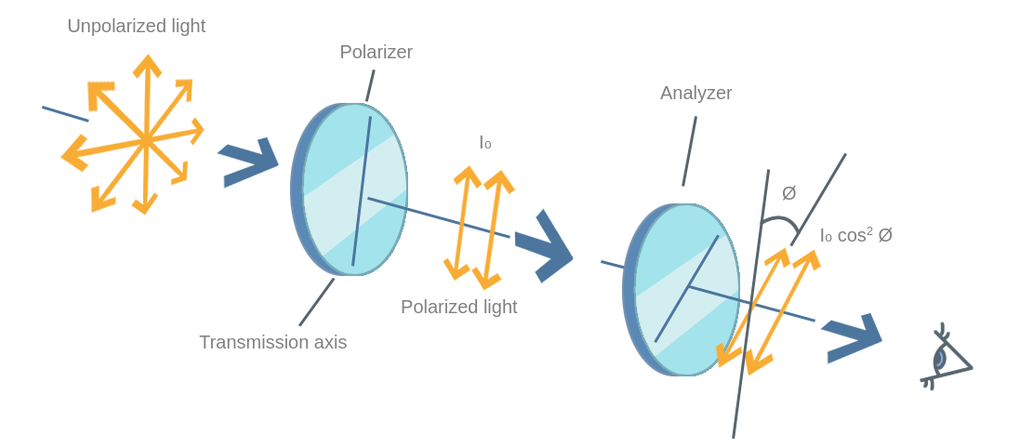 Malus’s law image Labster. Apologies, I’m not sure if this is an original image.
Malus’s law image Labster. Apologies, I’m not sure if this is an original image.
Measuring the polarization of the local photon doesn’t alter the remote photon, it alters the local photon. It rotates it, in line with I = I₀ cos²θ. When I dug deeper and looked at Bell’s inequality and the various experiments, I came to the conclusion that quantum entanglement is scientific fraud. In similar vein I think quantum computing is the preserve of quantum bullshitters spinning a jam-tomorrow yarn and sucking up money that ought to be going into bona-fide physics. So I don’t think this is a breakthrough. I think it’s just another puff of hype holding up a castle in the air. Next.
7. First X-ray image of a single atom
Next was First X-ray image of a single atom. It refers to the July Physics World article Synchrotron X-rays image a single atom, and the Nature paper Characterization of just one atom using synchrotron X-rays. What they’ve got here appears to be an improvement on the scanning tunnelling microscope via an “intense X-ray illumination”. The technique is known as “synchrotron X-ray scanning tunnelling microscopy (SX-STM)”. It sounds useful, fair play to Saw Wai Hla, Volker Rose, and 18 other researchers at Argonne. However I’d say it’s more of an incremental advance rather than a breakthrough. Sorry.
8. “Smoking gun” evidence of early galaxies transforming the universe
At number eight we had “Smoking gun” evidence of early galaxies transforming the universe. It concerns stellar UV radiation in the early universe. The EIGER collaboration used the James Webb Space Telescope (JWST) Near Infrared Camera “to find compelling evidence that early galaxies were responsible for the reionization of the early universe”. The team looked at light from quasars that had passed through “ionized bubbles” in space, and found a correlation between the locations of galaxies and the bubbles. See the July 2023 Physics World article JWST finds ‘smoking gun’ evidence of early galaxies transforming the universe. Also see the Astrophysical Journal paper EIGER. I. A Large Sample of [O iii]-emitting Galaxies at 5.3 < z < 6.9 and Direct Evidence for Local Reionization by Galaxies. It’s by Daichi Kashino and six other authors. I really like the James Webb Space Telescope, but I have to say I think this is telling us something we already know. Hence I don’t think it’s a breakthrough.
9. Supersonic cracks in materials
Johnston’s ninth item is Supersonic cracks in materials. It concerns Meng Wang, Songlin Shi and Jay Fineberg of the Hebrew University of Jerusalem. They found that “cracks in certain materials can spread faster than the speed of sound”. Whilst worthy, since we already know about shock waves which propagate faster than the speed of sound, I don’t see this as a breakthrough. Sorry again, especially since this work was done in Israel.
10. Antimatter does not fall up
Last and least is Antimatter does not fall up. CERN have been milking this for years, even though everybody in physics knows that the issue was never in doubt. It’s energy that causes gravity, and it’s energy that responds to gravity, whether it’s in the guise of light, matter, or antimatter. See the Wikipedia article Gravitational interaction of antimatter. It refers to the 1960 CPT theorem, and says antimatter falls down like ordinary matter. The bottom line is that CERN have been peddling woo about antimatter falling up for decades. This is definitely not a breakthrough.
11. Fusion energy breakthrough
Johnston also gave an “honourable mention” to a Fusion energy breakthrough. This concerned work at the National Ignition Facility. On 13th December 2022 they announced that NIF “produced 3.15 megajoules (MJ) of fusion energy output using 2.05 MJ of laser energy”. This was widely reported, but to be blunt it was hype. Tom Hartsfield explained it in Calm down. There’s no NIF fusion power “breakthrough”. He said “the input energy to the laser system is somewhere between 384 and 400 MJ. Consuming 400 MJ and producing 3.15 MJ is a net energy loss greater than 99%”. Hence I’m not impressed by this.
The Quanta magazine article on The Biggest Discoveries in Physics in 2023
I definitely wasn’t impressed by the Quanta magazine article on The Biggest Discoveries in Physics in 2023. It was by Nadia Drake and was headed up The Year in Physics. It started well enough with a piece called The Cosmos, Unveiled. It’s about the JWST, which observed early stars, very bright young galaxies, what looks like a surprisingly large number of supermassive black holes, and 42 intriguing pairs of objects that orbit one another.
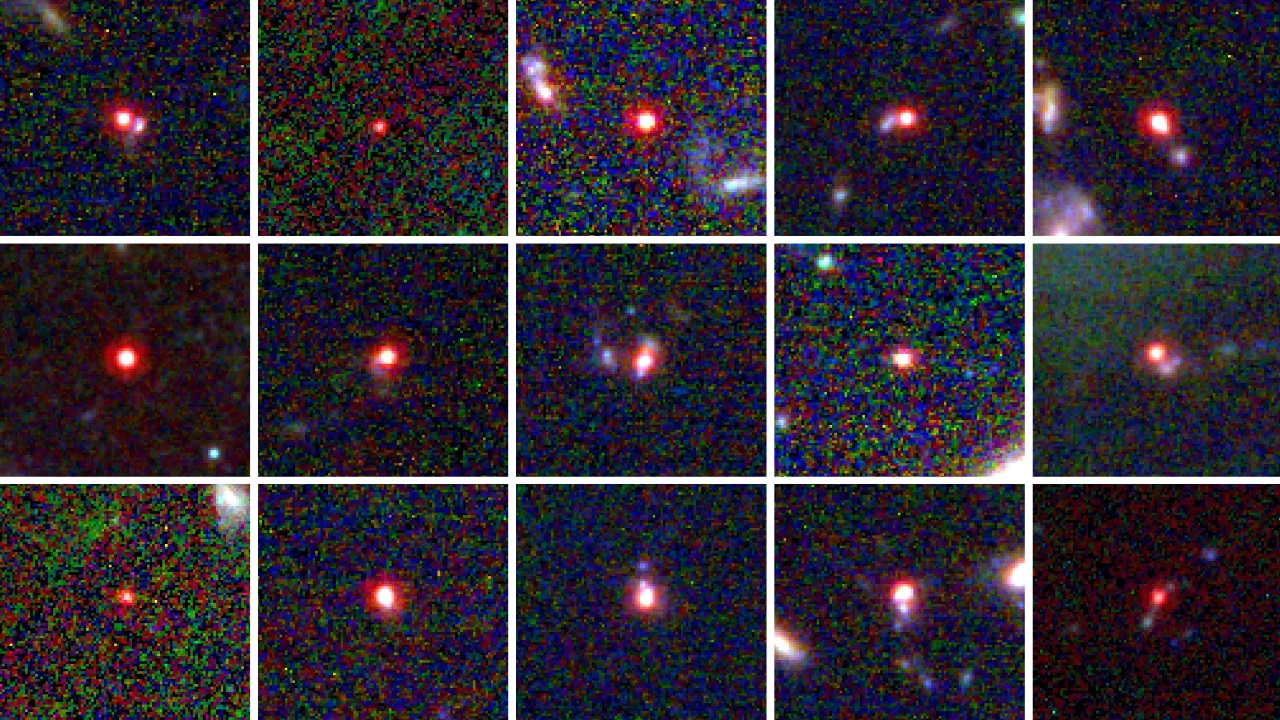 Caption: the young cosmos is home to a mystifyingly large population of tempestuous galaxies with large black holes at their cores. Courtesy of Jorryt Matthee. Data from the EIGER / FRESCO surveys.
Caption: the young cosmos is home to a mystifyingly large population of tempestuous galaxies with large black holes at their cores. Courtesy of Jorryt Matthee. Data from the EIGER / FRESCO surveys.
This JWST stuff is the right stuff, but I was a little surprised that there’s no overlap with the Physics World JWST item. Ditto for Quanta’s next item, A Hum of Gravitational Waves. This concerns pulsar observations over a 15-year period. They are said to demonstrate that the universe is full of very long wavelength gravitational waves, allegedly resulting from supermassive black hole mergers. My view on LIGO shapes my opinion on that, and the timing variations are so very minute I am not excited. The other “biggest discoveries” were Stronger Quantum Knots, Quantum Magic, and Toward Quantum Gravity. As ever Quanta are peddling the quantum bullshit with this. That’s what they do.
A blobby neutrino image of the Milky Way
The APS Physics magazine Highlights of the Year was very different. It started with the gravitational waves, see Researchers Capture Gravitational-Wave Background with Pulsar “Antennae”. Then it gave an item about the IceCube collaboration unveiling a blobby neutrino image of the Milky Way. See Milky Way Viewed through Neutrinos. I didn’t think it was much of a highlight myself. Then there was a piece on Might There Be No Quantum Gravity After All? As somebody who likes to think that I understand gravity and the quantum nature of light, I thought it didn’t live up to its title, and I was not impressed. I was not impressed by The Cost of Sending a Bit Across a Living Cell either. Or Quantum Repeater Goes the Distance, which was Hamish Johnston’s item 6. I particularly disliked See No Bias, Hear No Bias, Speak for No Change which was critical race theory dressed up as science. Then there was an opinion piece on How AI and ML Will Affect Physics), which I thought was valueless. In similar vein I did not feel any enthusiasm for the other “highlights of the year”, namely Tackling the Puzzle of Our Solar System’s Stability, New Accuracy Record for Molecular Lattice Clock, Vanishing Act for Water Waves, and Life at the South Pole Science Station.
There were no highlights
If felt the same lack of enthusiasm about the CERN highlights in 2023. That’s because there were no highlights. Anyway, as I expected, Hamish Johnston announced the brain–spine interface as the Physics World 2023 breakthrough of the Year. Like I said, I thought it was heartening and life-changing. This is good science. But as I also said, it’s neural engineering. It isn’t physics. In similar vein, Growing electrodes inside living tissue isn’t physics. This is moot because it’s Physics World. Not Science World. So, what were the breakthroughs in physics in 2023? I’d say the JWST really delivered, but that’s about it. I would love to see Neutrinos probe the proton’s structure turn into something that bends the Standard Model towards TQFT, but I am not optimistic. I would love to see a fusion energy breakthrough, but I’m not convinced it will come from Big Science. I’d love to learn something about the evolution of universe from the pulsars, but the timing variations are so small, and the leaps to the conclusions are so large.
2023 was a nothingburger
So where does that leave us? I’d say a lot of the items I’ve mentioned were worthy work by dedicated scientists, but were incremental advances rather than breakthroughs. Others were not so worthy. All in all, I’d say that with the exception of JWST, when it comes to physics breakthroughs, 2023 was a nothingburger. I am reminded of the BBC. We pay them billions of pounds, and all we get for it is propaganda, censorship, wokery, greenwash, antisemitism, and fatcat salaries. The same is true of academia. We pay them billions of pounds and what do we get in return? Clean cheap energy? Planes that don’t pollute the skies? Free speech in science? No, what we get is the mainstream narrative, transvestite thuggery, terrorist sympathisers, and back door immigration for foreign students who don’t make the grade. We are paying billions in science funding to people who despise us, and who make it their business to stifle scientific progress. More and more people are aware of this every day. It’s going to be fun to watch this one play out. Meanwhile let’s hope that there’s some better breakthroughs this year.
Hi John, long time.
.
If you want a real science breakthrough on Bell’s inequalities, I suggest you go back to Joy Chrisitian which you already mentioned in the post “quantum entanglement is scientific fraud”. https://arxiv.org/pdf/1911.11578.pdf
.
And before you begin, you can’t explain Bell’s correlations simply with malus’ law (which i anticipate is going to be in your reply). Malus’ law would not always give agreements between identically angled detectors if the hidden photon polarization was not aligned relative to these (for example, if the two photons are at polarization angle x relative to the detectors, each would have an independent chance of cos(x) to pass. Meaning, sometimes one can pass while the other won’t, because cos(x)=1 only for angles x=0. This is in contradiction with experiment, where both detectors will give ALWAYS the same results).
.
This paper by Joy in particular shows exactly why this cosine flipping happens with a very easy to understand 2D analogue of the experiment. The entangled photons have ALWAYS the same polarization (well, orthogonal, but it doesn’t matter); it’s the inherent twisted topology of our space which “distorts” the photon in random directions relative to each other. The amount of this twist depends exclusively by the relative positions of the two detectors that make the measurement, but is NOT CAUSED by them. I’m available for any clarification on this paper, which I found quite honestly insanely underappreciated, like all of Joy’s work.
Thanks for this Sandra. I will take a good look at Joy Christian’s 2019 paper Dr. Bertlmann’s Socks in the Quaternionic World of Ambidextral Reality. I will give a considered reply here. You will be aware that I’ve spoken about Möbius strips and the twisted topology of space in a number of my articles, and I’ve likened the electron to a Hopf fibration. So there is some common ground. I will come back to Bell and Malus after that.
.
Meanwhile, what do you think of the physics breakthroughs 2023? Please note that I wrote Quantum computing and the quantum quacks nearly five years ago, and still feel unhappy about the way people treated Joy Christian. I see that his latest paper on the ArXiv is https://arxiv.org/abs/2302.09519, which was revised on 24th January 24.
Joy’s papers suffered mainly from… publicity by bad faith actors. Scott Aaronson is one of these, and a certain Gill, which is still militant in both physics stackexchange and physicsforums. Neither of them has absolutely any clue about geometric algebra and its nuances (as is evident from their criticisms, and Joy’s answer thereof), yet felt the need to repeatedly diss these papers and sink them in the unknown depths of arxiv and second hand journals. I believe one of the two went as far as forcing one journal to retract one of his papers. Truly a sad story of human nature.
.
If I have to choose, the top story of 2023 was a final nail on the coffin of lambda-CDM by the JWST. I don’t have a specific article in mind, it was probably a joint collaboration and multiple data analysis. Yet, certain physicists STILL insist that there must be something wrong with the distance ladder. I hope we don’t get a new Joy Christian situation.
Yes, truly a sad story. What surprises me is how Richard D Gill, a statistician, had any influence at all. But there again, challenging spooky action at a distance doesn’t make you any friends.
.
I somehow missed the Lambda-CDM final nail thing. For example, I didn’t see this SciAm article dated December 6th 2022: Astronomers Grapple with JWST’s Discovery of Early Galaxies. Perhaps I was tied up with quantum entanglement, then my trip to Australia, and there’s been some closing of ranks since. Which is sad, because IMHO when you understand gravity, you realise that there are some clear issues in modern cosmology. Anyway, thanks for the info.
Time for my personal nomination for the The Happy
Horsehit Awards, with this exercise in science writing futility on Physics.Orgre : https://phys.org/news/2023-11-racehorses-theyre.html
That truly is horseshit, Greg. My Dad (Lord rest his soul) used to have racehorses. He wasn’t particularly successful with them, but no matter. The point is that I recall one particular horse that he was particularly enthusiastic about. He told me “it really wanted to win”, and that the jockey had to try and rein it back so it saved some energy for the finish. Unfortunately I can’t remember its name now. But anyway, horses aren’t that stupid. They even have a sense of humour.
Yea, my last scan of current websites such as Physics.Orgre, SciPopDaily, Naturecalls.org, ect……reveal two things: 1.the Dr. Roy Kerr controversy has been swept under an already filthy rug by the S.M. establishment. 2. That same establishment has doubled down on wanting a new $10.billion collider for the sole purpose of searching for a higly polished turd miracle hypothesis of : “DARK PHOTONS!!!” A quick Internet search found at least two preexisting t.v. shows/comic characters amongst others.
Therefore, I too shall commit my entire scientific resolve to such Ferengi level hi-jinks, tomfoolery,and even academic hooliganisms……
Signed : Dark Foton, 33° Master of Bullshito
Internet searches provided by: Dark Foton, 33° Master of Bullshito
Yes Greg, swept under the rug. The censorship just gets worse. And sigh, dark photons, the pseudoscience just gets worse. Have you seen this dollop of bullshit? “Our work shows that the dark photon hypothesis is preferred over the standard model hypothesis at a significance of 6.5 sigma, which constitutes evidence for a particle discovery.” — Professor Anthony Thomas . No, your Humpty Dumpty sigma declaration does not constitute evidence of a particle discovery.
I now stand corrected, the price tag is up to $17 billion greenbacks ! I’m just as deserving a large slice of the greed pie as the rest of the pack of wolves ?
https://www.nature.com/articles/d41586-024-00353-9
Thanks Dark Foton. I read it:
.
“Europe is pushing forwards with plans to build a 91-kilometre-long, 15-billion-swiss-franc (US$17-billion) supercollider underneath the French and Swiss countryside. The machine would allow researchers to study the Higgs boson in detail. But scientists are under pressure to convince funders that such an enormous investment is worth it, following the lack of new physics revealed by the Large Hadron Collider (LHC)… The planned machine would collide electrons with their antimatter partners, positrons, from around 2045, with the aim of generating and studying in precise detail around one million Higgs bosons.”
.
What a pity the “discovery” of the Higgs boson was scientific fraud, just like the “discovery” of the W and Z bosons. What a pity that people involved with CERN know this full well. And what a pity that they continue to censor the bona-fide physics that threatens their vested interest. How did scientists become so inverted?
This seems interesting , anything new or exciting about ?,
:https://www.smartnews.com/p/4647125260859086322?placement=article-preview-social&utm_source=share_android_other&utm_campaign=sn_lid%3A4647125260859086
Thanks for letting me know about it. Keep these news reports coming! My weekend was filled with commitments, and I had no free time. I don’t talk about heat much because heat is, in essence, motion. A “hot” electron is merely a fast-moving electron. Ditto for atoms or molecules in a hot gas. In a hot solid, the atoms are vibrating. However I wonder if this article may be relevant to the early universe. In misconceptions skewered I said “Or did space ring like a bell and was suddenly full of waves and pair production and annihilation and fusion and everything else? I don’t know, and I’m not sure I’ll ever know”. Maybe this work is pointing to some way to emulate the early universe. Perhaps a way that’s better than the BEC work I was disparaging about above. Or perhaps not. Either way, thanks for mentioning it.
1st fluids, 2nd fluids, quite a new rabbit hole of newness for me to correlate. My first layman’s interpretations were : 1.Why WOULDN’T heat move in waves? 2.This is a really neat example of the Laws of Thermodynamics in action? 3. Could a basic concept of an Einsteinian/William Kingdon Clifford model of space be a superfliud like substance itself ?
Not to worry, my dunce cap is at the ever ready to be worn……..
Wowsers! John, check this out :
https://www.nature.com/articles/s41467-024-45225-y
“By leveraging the emerging magnetic Weyl semimetals, we further show how a giant bulk effective magnetoelectric effect can be achieved in a proposed metamaterial, exceeding that of natural materials by almost four orders of magnitude”. It’s only a proposal, but if they’re saying they can make a magnet 10,000 times as strong as my bad-boy drain-cover lifter, that might be promising. I will have a look at this.
The graphics they use of torsional shapes for illustrations are eriely simular to many of yours. Maybe Spin Dizzys could happen, who the F really knows?
Spinning Dizzys are at least a much more plausible scenario than any crock of S.M. bullshitto.
I will have a proper look DFI. But they’re depicting gyroelectric as orthogonal to gyromagnetic, so I’m thinking they don’t have a handle on electromagnetism, wherein the so-called electric wave is the spatial derivative of the electromagnetic wave and the so-called magnetic wave is merely the time derivative. Hence I’m not optimistic. But hey, if there’s some issue with the depiction, that doesn’t matter if they can achieve a result.
Your clarifications on submitted articles are always sufficient to clarify my continually evolving views. Information Conflation/Overload is a very real thing for this layman.
Also I forgot: Kudos for the format update a short while back !
Always a pleasure DF! Thanks!
Hello all, this is my first time posting on this site. I would agree that all QED since 1935 is BS. But if that is the case we must go back to before 1935 and start over on a different path.
My understanding is that once Rutherford discovered the nature of the nucleus of the atom he could not explain why the hydrogen atom did not collapse due to the electrostatic force of attraction between the electron and proton.
What if the problem was that Coulomb’s law could not be applied to the proton. Coulomb’s law works for both conductors and insulators, each for different mechanisms. I would say that a proton would not look like either. Consider a boundary condition that the electric flux density on the surface of the proton is fixed. From this assumption we see a stable hydrogen atom using only electrostatic force, no angular momentum required.
If this sounds interesting please visit my web site https://polata-atomic-model.org
Regards,
Anthony
I’m always interest in physics, anthony. I took a look at your web site and saw this: “While the electron is a point particle something on the order of 1×10ˉ¹⁸ meters”. That’s what people say about the electron, but it’s the wave nature of matter, and the electron doesn’t have a Compton wavelength for nothing. People like de Broglie, Schrodinger, Darwin, and Born and Infeld all talked of a wave in a closed path. IMHO the hydrogen atom does not collapse because the electron sits around the proton like a hula hoop. See pair production and the electron for my take on it.
Thanks for taking a look. We are definitely more in the point-particle camp. I wish I could say something significant about the Compton wavelength, but about all I can say is that I don’t think it’s in conflict with how we see atoms working. Pretty sure the 10-18 meters was found in the early 1990s. The important thing being that the proton is orders of magnitude larger than the electron, at least classically. In fact we think of the atomic system as being completely classical, well perhaps except for the part about throwing Coulomb’s law under the bus. Anyway thank you again for taking a look, I appreciate that very much.
Regards,
Anthony
It wasn’t actually found, Anthony. I likened the situation to hanging out of a helicopter probing a whirlpool with a bargepole, and then saying “I can’t feel the billiard-ball so it must be really small”.


.
.
IMHO the best way to think about this is to say the electron’s field is what it is. It isn’t a point-particle that has a field, it is field. Or a field knot, as it were. So whilst it might have an inner circumference, it doesn’t have a size like a billiard ball. In knot theory, which relates to TQFT, the simplest knot is the trivial knot. The next simplest knot is the trefoil knot, as depicted on the right below.
.
.
Trace around the trefoil anticlockwise from the bottom left calling out the crossing-over directions: up down up,. Does that sound familiar? I think the electron and the proton will never annihilate because whilst they have the opposite chirality and attract like counter-rotating vortices attract, they do not have the same topology.
Thank you again for your time, I fear I am taking up too much of it. But to answer you no it does not sound familiar, pretty much none of it. Consider that in the case of a hydrogen atom your grandmother has a vague understanding that Schrodinger’s equation deals with the probability distribution of an electron cloud surrounding a proton. Could you explain chirality, counter-rotaing vortices and differing topology to her?
Well I suppose I intended that to be more of a thought experiment as opposed to a call to action. Again I apologize for taking up too much of your time. I’ll just get back to my knitting 😉
Regards,
Perhaps it doesn’t sound familiar because you don’t hear about what the “realists” said in the 1920s. People like Schrödinger talked about a wave in a closed path, whilst the Copenhagen school spoke of the probability of finding a point-particle electron. The latter view has prevailed, even though we had hard scientific evidence of the wave nature of matter by 1927. I’ve tried to understand why, see my historical articles. I think it was due to the rise of the Nazis followed by the second World War followed by Feynman.
.
Yes, I can explain chirality to my grandmother. She knows all about knots because of her knitting. She also knows that you can tie your shoelaces left-over-right or right-over-left. She knows about vortices because she has a kitchen sink. She’s made Falaco solitons with a plate, and then she’s watched the water drain down the plughole. My grandmother understands this stuff better than most. Well, she would if she was still with us, if you catch my drift. I guess you read this where I talked about explaining it to your grandmother. Don’t apologize for taking up my time. I love this stuff.
https://www.sciencedirect.com/science/article/pii/S0360319922022406 Here is an explanation and also perhaps the physics discovery of the century…. As the opposition to this is so violent but evidence just keeps piling up one wonders what’s to hide or is it just protecting the status quo.
A little bird tells me Hagen has a new paper in the offing and even more evidence so let’s see what come out later this year.
I’ll take a look, Andrew. I’ve never been too impressed by the hydrino, because like Rutherford I think a neutron is akin to a close-coupled hydrogen atom. But I’ll see what it says.
Well said. Another thing we need to advocate is the cleansing of the inconsistency in “all advanced thermodynamics textbooks” (https://blogdredd.blogspot.com/2024/02/the-photon-current-3.html).
Hi Dredd. Take a look at “Taming light at the nanoscale” by Nader Engheta: https://attachment.tapatalk-cdn.com/2259/201902/2_7a474ff05fd2abb7866aa40d8a75bbb8.pdf . The photon is displacement current. This is why after pair production, the electron has a magnetic moment. It’s essentially a 511keV photon in a closed path.
Thanks.
Dear Physics Detective:
Please don’t indict these doods … unless we have to (Small Brains Considered – 7).